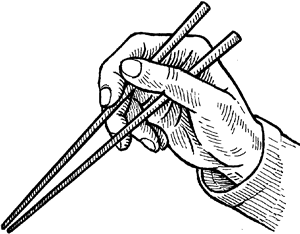Chopsticks
Chopsticks are small, often tapered, sticks used in pairs of equal length as the traditional eating utensils of China, Japan, Korea, Vietnam, Thailand and Burma. Generally, it’s believed to have originated in ancient China. Chopsticks are most commonly made of bamboo or plastic, but are also made of metal, bone, ivory, and various types of wood. The pair of sticks is maneuvered in one hand, between the thumb and fingers, and used to pick up pieces of food.
The English word "chopstick" seems to have been derived from Chinese Pidgin English, a pidgin in which "chop chop" meant quickly. There are several styles of Chopsticks that vary in respect to Length, tapering Material and Embellishments; according to the culture of the country.
Etiquette
Chopsticks are used in many parts of the world. While principles of etiquette are similar, the finer points may differ from region to region, and there is no single standard for the use of chopsticks. Generally, chopsticks etiquette is similar to general western etiquette regarding eating utensils.
Universal etiquette
· Chopsticks are not used to make noise, to draw attention. Playing with chopsticks is considered bad mannered, rude and vulgar
· Chopsticks are not used to move bowls or plates.
· Chopsticks are not used to impale food.
· Chopsticks should not be left standing vertically in a bowl of rice or other food. Any pair of stick-like objects pointed upward resembles the incense sticks that some Asians use as offerings to deceased family members; certain funerary rites designate offerings of food to the dead using standing chopsticks.
Chinese etiquette
· In Chinese culture, it is normal to hold the rice bowl up to one's mouth and use chopsticks to push rice directly into the mouth.
· It is acceptable to transfer food to closely related people (e.g. grandparents, parents, spouse, children, or significant others) if they are having difficulty picking up the food. Also it is a sign of respect to pass food to the elderly first before the dinner starts.
· It is poor etiquette to tap chopsticks on the edge of one's bowl, as beggars are believed to make this noise to attract attention.
· It is impolite to spear food with a chopstick, unless the food is difficult to handle, such as fish balls.
· It is considered poor etiquette to point rested chopsticks towards others seated at the table.
· Chopsticks should not be left vertically stuck into a bowl of rice because it resembles the ritual of incense-burning that symbolizes "feeding" the dead and death in general.
· Holding chopsticks incorrectly will reflect badly on your parents, who have the responsibility of teaching their children.
Hong Kong etiquette
· The eldest (most respected) member of the family holds his/her chopsticks first.
· Chopsticks are not to be used backwards. However it is "acceptable" to use backwards chopstick to stir or transfer the dish to another plate (if the person is not intending to eat it). This method is used only if there is no serving chopstick around.
· Resting chopsticks at the top of the bowl means "I've finished". Resting chopsticks on the chopstick stands means "I'd like to continue but am taking a break."
Taiwanese etiquette
· Food should not be transferred between chopsticks. Food in need of transportation should be placed onto the recipient's plate or on a new plate for collection.
· Using chopsticks like a knife and fork to cut soft foods into smaller portions for children is widely accepted.
· Chopsticks should not be planted on the rice such that they stand up, as this resembles incense stuck in the ash of a censer, thus connected with death.
· Chopsticks should not be rested on the table but rather on a provided chopstick rest or lying across the rice bowl in a sideways fashion. Alternatively, they can be placed flat on the bowl when finished.
· Chopsticks should not be bitten on, or linger in one's mouth for too long.
Japanese etiquette
· Food should not be transferred from one's own chopsticks to someone else's chopsticks. Japanese people will always offer their plate to transfer it directly, or pass a person's plate along if the distance is great. Transferring directly with chopsticks is how bones are passed as part of Japanese funeral rites.
· The pointed ends of the chopsticks should be placed on a chopstick rest when the chopsticks are not being used. However, when a chopstick rest is not available as it is often the case in restaurants using Waribashi (disposable chopsticks), a person may make a chopstick rest by folding the paper case that contained the chopsticks.
· Reversing chopsticks to use the opposite clean end is commonly used to move food from a communal plate, although it is not considered to be proper manners. Rather, the group should ask for extra chopsticks to transfer food from a communal plate.
· Chopsticks should not be crossed on a table, as this symbolizes death, or vertically stuck in the rice, which is done during a funeral.
· It is rude to rub wooden chopsticks together after breaking them apart, as this communicates to the host that the user thinks the chopsticks are cheap.
· Chopsticks should be placed right-left direction; the tips should be on the left. Placing diagonal, vertical and crossing each stick are not acceptable both in home and restaurant manners.
· In formal use, Waribashi should be replaced into the wrapper at the end of a meal.
Korean etiquette
· In Korea, chopsticks are paired with a spoon, and there are conventions for how these are used together.
· It is considered uncultured and rude to pick up a dish or a bowl to bring it closer to one's mouth, and eat its content with chopsticks (except certain noodle dishes like naengmyeon). Dishes are to be left on the table at all times, and a spoon is used alongside chopsticks, if the food lifted "drips". This is in stark contrast to Chinese and Japanese convention, which lifts up the rice bowl, often to the mouth.
· When laying chopsticks down on the table next to a spoon, one must never put the chopsticks to the left of the spoon. Chopsticks are only laid to the left during the food preparation for the funeral or the memorial service for the deceased family members, known as Jesa.
· It is rude to use the same hand to hold both chopsticks and a spoon at the same time and laying the spoon down on the table while one uses chopsticks.
· Use a spoon to eat soup, stew and liquid side dishes and solid side dishes for chopsticks. But both flatwares can be used for eating rice.
Vietnamese etiquette
· As with Chinese etiquette, the rice bowl is raised to the mouth and the rice is pushed into the mouth using the chopsticks.
· Unlike with Chinese dishes, it is also practical to use chopsticks to pick up rice in plates, such as fried rice, because Vietnamese rice is typically sticky.
· It is proper to always use two chopsticks at once, even when using them for stirring.
· One should not pick up food from the table and place it directly in the mouth. Food must be placed in your own bowl first.
· Chopsticks should not be placed in the mouth while choosing food.
· Chopsticks should never be placed in a "V" shape when done eating; it is interpreted as a bad omen.



Comments
Post a Comment